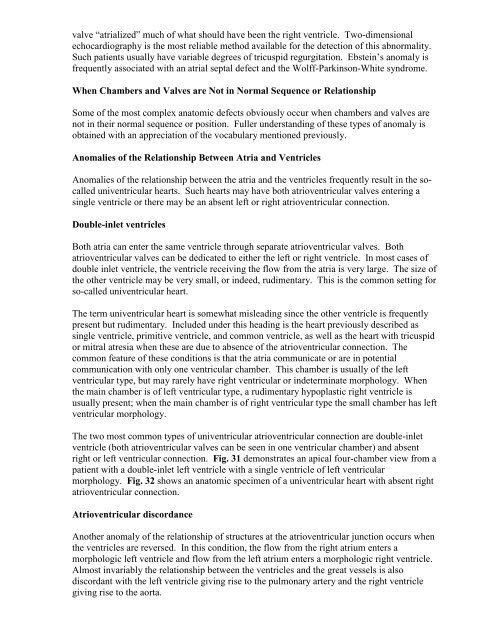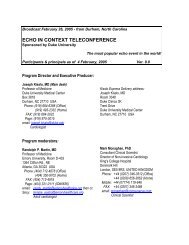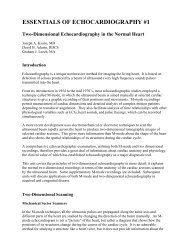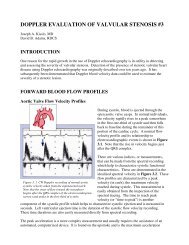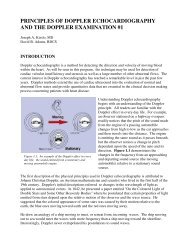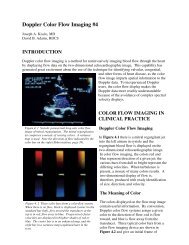ESSENTIALS OF ECHOCARDIOGRAPHY #4 - Echo in Context
ESSENTIALS OF ECHOCARDIOGRAPHY #4 - Echo in Context
ESSENTIALS OF ECHOCARDIOGRAPHY #4 - Echo in Context
You also want an ePaper? Increase the reach of your titles
YUMPU automatically turns print PDFs into web optimized ePapers that Google loves.
valve “atrialized” much of what should have been the right ventricle. Two-dimensionalechocardiography is the most reliable method available for the detection of this abnormality.Such patients usually have variable degrees of tricuspid regurgitation. Ebste<strong>in</strong>’s anomaly isfrequently associated with an atrial septal defect and the Wolff-Park<strong>in</strong>son-White syndrome.When Chambers and Valves are Not <strong>in</strong> Normal Sequence or RelationshipSome of the most complex anatomic defects obviously occur when chambers and valves arenot <strong>in</strong> their normal sequence or position. Fuller understand<strong>in</strong>g of these types of anomaly isobta<strong>in</strong>ed with an appreciation of the vocabulary mentioned previously.Anomalies of the Relationship Between Atria and VentriclesAnomalies of the relationship between the atria and the ventricles frequently result <strong>in</strong> the socalleduniventricular hearts. Such hearts may have both atrioventricular valves enter<strong>in</strong>g as<strong>in</strong>gle ventricle or there may be an absent left or right atrioventricular connection.Double-<strong>in</strong>let ventriclesBoth atria can enter the same ventricle through separate atrioventricular valves. Bothatrioventricular valves can be dedicated to either the left or right ventricle. In most cases ofdouble <strong>in</strong>let ventricle, the ventricle receiv<strong>in</strong>g the flow from the atria is very large. The size ofthe other ventricle may be very small, or <strong>in</strong>deed, rudimentary. This is the common sett<strong>in</strong>g forso-called univentricular heart.The term univentricular heart is somewhat mislead<strong>in</strong>g s<strong>in</strong>ce the other ventricle is frequentlypresent but rudimentary. Included under this head<strong>in</strong>g is the heart previously described ass<strong>in</strong>gle ventricle, primitive ventricle, and common ventricle, as well as the heart with tricuspidor mitral atresia when these are due to absence of the atrioventricular connection. Thecommon feature of these conditions is that the atria communicate or are <strong>in</strong> potentialcommunication with only one ventricular chamber. This chamber is usually of the leftventricular type, but may rarely have right ventricular or <strong>in</strong>determ<strong>in</strong>ate morphology. Whenthe ma<strong>in</strong> chamber is of left ventricular type, a rudimentary hypoplastic right ventricle isusually present; when the ma<strong>in</strong> chamber is of right ventricular type the small chamber has leftventricular morphology.The two most common types of univentricular atrioventricular connection are double-<strong>in</strong>letventricle (both atrioventricular valves can be seen <strong>in</strong> one ventricular chamber) and absentright or left ventricular connection. Fig. 31 demonstrates an apical four-chamber view from apatient with a double-<strong>in</strong>let left ventricle with a s<strong>in</strong>gle ventricle of left ventricularmorphology. Fig. 32 shows an anatomic specimen of a univentricular heart with absent rightatrioventricular connection.Atrioventricular discordanceAnother anomaly of the relationship of structures at the atrioventricular junction occurs whenthe ventricles are reversed. In this condition, the flow from the right atrium enters amorphologic left ventricle and flow from the left atrium enters a morphologic right ventricle.Almost <strong>in</strong>variably the relationship between the ventricles and the great vessels is alsodiscordant with the left ventricle giv<strong>in</strong>g rise to the pulmonary artery and the right ventriclegiv<strong>in</strong>g rise to the aorta.


